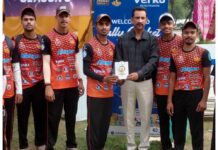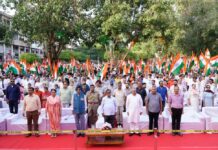From Mother Tongue to Other Tongue
Resurrecting the ethos of Bharatiyata
Dharmendra Pradhan
Bharatiya Bhasha Utsav, a week-long celebration from 4th to 11th December to mark our diverse linguistic heritage and to commemorate the birth Anniversary of the revered Mahakavi Subramania Bharati on December 11 is currently underway in all States and UTs. ‘Unity through Languages’ is the defining theme of this year’s celebration, that captures the very essence of Bharat’s civilizational ethos. Just a couple of months back, on 3rd October, 2024, the Union Cabinet under the leadership of Prime Minister Narendra Modi created a history of sorts by conferring the status of Classical Languages to as many as five languages – Marathi, Pali, Prakrit, Assamese and Bengali, thus expanding the ambit of already recognized six other Classical Languages such as Tamil, Sanskrit, Telugu, Kannada, Malayalam and Odia. A profound acknowledgement of Bharat’s exalted linguistic heritage, this pronouncement makes each one of our people having these languages a mother tongue, immensely proud.
India’s diverse languages are expressions of Bharatiyata and these are intrinsic to our Indian Knowledge System. According to the Prime Minister Narendra Modi, all Indian languages are national languages and they constitute the soul of Bharatiyata and hence, worthy of reverence. Linguistic diversity strengthens national unity and helps realize the goal of ‘Ek Bharat Sresth Bharat’. Each one of our people, therefore, must wear linguistic pride as a badge of honour. The Prime Minister exemplified this even at the global stage when he emphatically said, “I proudly speak India’s languages even at the UN. If it takes a while for the listeners to applaud, so be it.” This assertion underscores his commitment to preserving India’s linguistic diversity and highlights the value of linguistic pride.
Bharat is a land where multiple languages not only coexist but thrive. It is a living embodiment of the profound sublimity of multilingualism. Our linguistic diversity forms a rich, intricate tapestry, weaving together our national identity while nurturing the country’s unity amidst bewildering diversity. This cultural strength faced massive erosion during colonial rule. On 2nd February 1835, Thomas Babington Macaulay presented a memorandum, known as “Macaulay’s Minute on Indian Education” to then Governor General of India, prioritizing English over native tongues that sought to create a class of Indians loyal to British interests, alienating generations from their cultural and linguistic roots. Ever since, an unwholesome colonial legacy lingered over centuries, grievously injuring our cultural and linguistic pride.
Bharat has a rich and diverse lingual demographic, with an overwhelmingly eighty per cent of the population identify themselves as Non-English, Native Language speakers. At the core of deeper learning is the mother tongue. Our languages are not just tools of communication—they are the repositories of history, traditions, and folklore, preserving the collective wisdom of generations and offering a unique worldview. Children, brimming with creativity and emotional intelligence, flourish when their education begins in their native language. A Primer in their mother tongue builds a seamless bridge from home to classroom, guiding them from ‘mother’ tongue to ‘other’ tongue—transitioning from speaking to writing, vocabulary to semantics, and language to subject comprehension. As Rabindranath Tagore poignantly noted, “A child learns to speak not from textbooks, but from his mother.” Education in the mother tongue fosters a natural progression from basic understanding to complex thought.
Bharat’s linguistic diversity is a treasure-trove of both intellectual and cultural wealth. From the snow-capped peaks of Kashmir to the sun-drenched shores of Kanyakumari, and from the arid expanses of Kutch to the verdant hills of Kohima, our languages encapsulate the inner essence of our people. Teaching children in their mother tongue not only preserves their connection to heritage but also equips them for the future. By laying a robust foundation in the native language, we can empower children to master other languages and subjects with greater ease and comprehension.
The National Education Policy (NEP) 2020 copiously embraces this vision. Seeking to reclaim our linguistic heritage, NEP places the mother tongue at the heart of early education, acknowledging that language is not merely a tool for learning but a core component of shaping identity, building confidence and fostering cognitive development.
The NEP 2020 necessitates equitable access to high-quality teaching and learning materials in various Indian languages for greater learning outcomes. It places strong emphasis on the fusion of technology with education, particularly in the context of preserving and promoting the nation’s diverse linguistic heritage. From Bhasha Sangam programme and Machine Translation Centre of National Council of Educational Research and Training to Anuvadini App based translation of books including technical books in multiple Indian languages by All India Council for Technical Education to ASMITA – Augmenting Study Materials in Indian Languages through Translation and Academic Writing – initiative by University Grants Commission and Bharatiya Bhasa Samiti, there have been well-concerted efforts to create a robust ecosystem for promotion of Indian languages so as to make education inclusive.
Besides, the Government’s groundbreaking initiative to produce Primers in 79 Indian languages is a monumental step forward, guaranteeing that children during early years, in rural, tribal, and remote areas receive quality education in their native tongues. These Primers, alongside other educational materials, are more than just resources—they are gateways to creativity, critical thinking, and lifelong learning.
Language shapes our thoughts, expresses our emotions, and connects us to our cultural roots. The NEP 2020 heralds a new era, where children can learn in their mother tongue and gradually master other languages. By decolonizing our education system, we seek to nurturing a generation of thinkers who will not only excel academically but also champion Bharat’s rich cultural heritage. This transformation is not merely a policy shift—it represents a cultural renaissance.
As we look to the future, Bharat’s linguistic diversity will be a cornerstone of educational excellence and socio-cultural and economic advancement. In this Amrit Kaal, as we pursue a Vikasit Bharat agenda, our mother tongues are poised to become powerful vehicles of development. Let us make our linguistic heritage the fulcrum of our progress, as Bharat ascends on the global stage.














